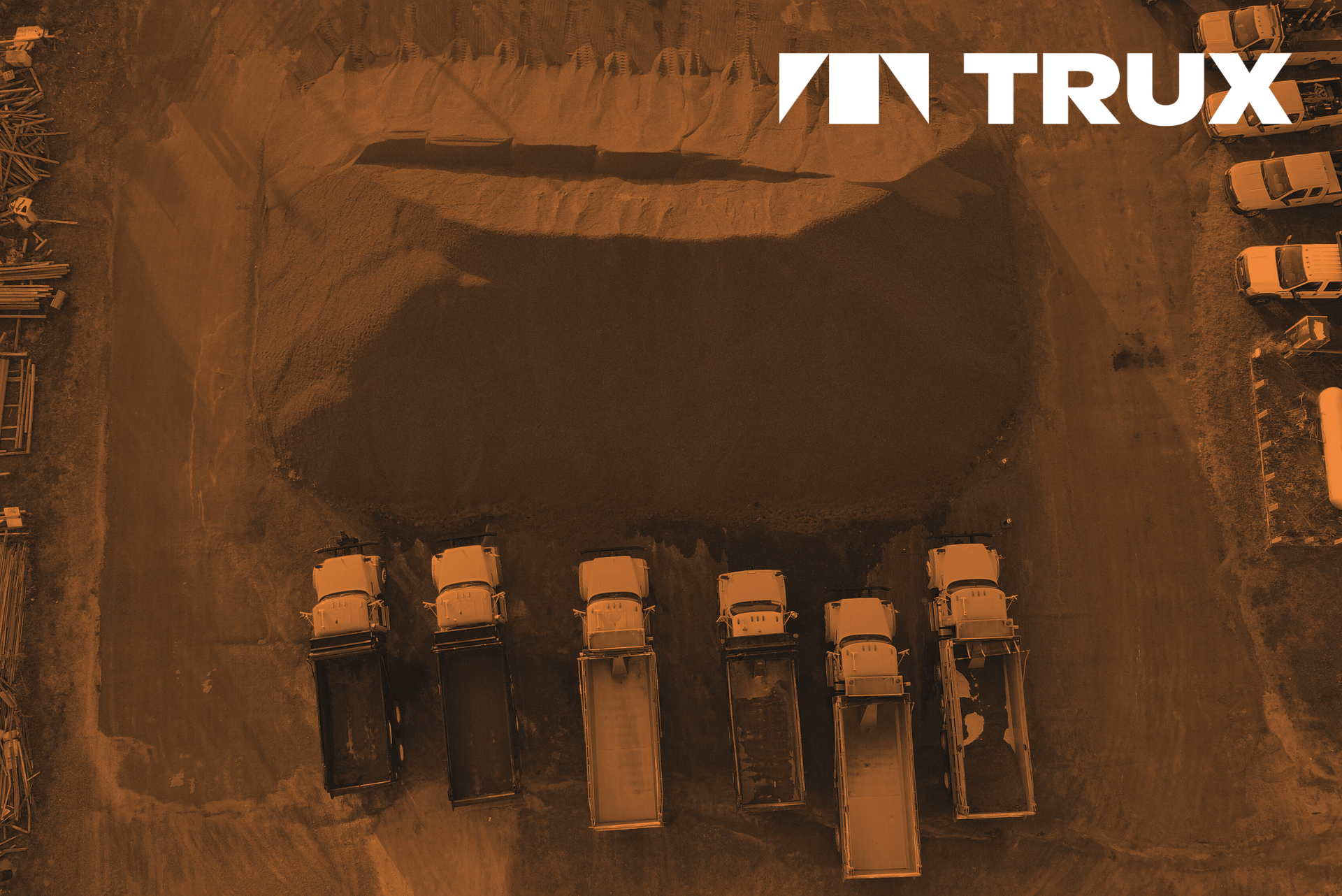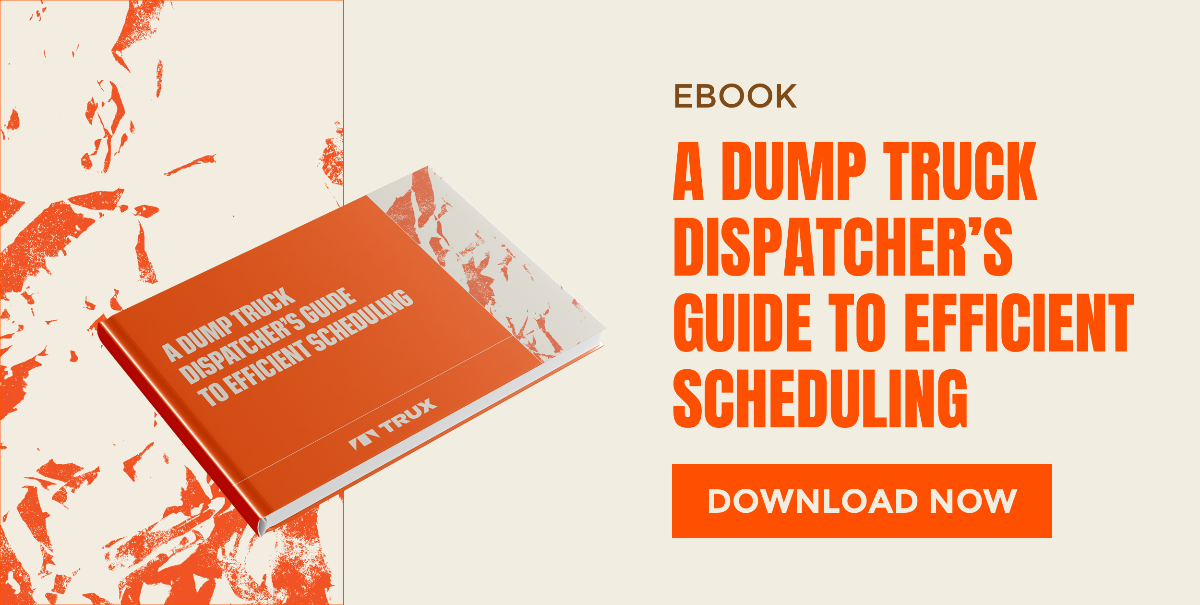8 min read
Balancing Pickups and Deliveries: Why a Delivery-First Model Wins
By: TRUX Team on Nov 27, 2024 8:34:30 AM

Material producers are the backbone of construction projects, ensuring that essential aggregates like sand, gravel, and asphalt reach job sites efficiently. Today, most producers rely heavily on customer pickups to move materials. While this approach has its advantages, it also leaves significant opportunities on the table.
By shifting the focus to majority deliveries, producers can offer a more seamless experience for their customers, boost operational control, and open up new revenue streams. In this blog, we’ll break down the key differences between pickups and deliveries, explain the benefits of a delivery-focused approach, and provide practical strategies for adopting this model.
Click a topic below to jump to the relevant section:
The Key Differences Between Deliveries and Pickups
Advantages of Emphasizing Deliveries
Addressing Common Challenges with Deliveries
Why Deliveries Provide a Competitive Advantage
The Key Differences Between Deliveries and Pickups
To understand the value of a delivery-first approach, it’s important to look at the fundamental differences between material deliveries and pickups. While both serve the same end goal—getting materials where they need to be—they place responsibility and control in very different hands.
Operational Responsibility
- Deliveries: The producer takes charge of the transportation process, coordinating logistics to ensure that materials are delivered to job sites accurately and on time. This requires robust dispatching systems and close oversight but allows producers to maintain control over the process.
- Pickups: Responsibility shifts to the customer, who arranges their own transport and manages their own schedules. While this reduces the logistical burden on producers, it can lead to inefficiencies if customers arrive late or unprepared for loading.
Scheduling and Logistics
- Deliveries: Precise scheduling is essential to avoid bottlenecks at the loading site or on the road. Dispatch teams must optimize truck routes, manage driver availability, and coordinate arrival times at job sites. This added complexity can be streamlined with tools like real-time GPS tracking and automated dispatch software.
- Pickups: Scheduling is simpler from the producer’s perspective since customers handle their own transport. However, unpredictable arrival times and uncoordinated hauler logistics can cause delays at the plant, impacting overall efficiency.
By comparing these key aspects, it becomes clear that while pickups are simpler to manage, deliveries offer a unique opportunity for producers to enhance efficiency, provide better customer service, and stand out in a competitive market.
Advantages of Emphasizing Deliveries
Shifting focus to material deliveries allows producers to create new value for both their business and their customers. By managing transportation in-house or through reliable third-party haulers, producers can unlock several distinct advantages.
1. Increased Revenue Opportunities
Deliveries open the door to premium pricing. Customers are willing to pay extra for the convenience of having materials arrive directly at their job sites, saving them time and logistical headaches. Additionally, producers gain access to a broader market—serving contractors without their own hauling capacity who might otherwise choose competitors offering delivery services.
2. Improved Customer Experience
When producers handle deliveries, customers benefit from simplified logistics and reliable service. Timely deliveries reduce delays on job sites and help contractors stay on schedule. By taking on this responsibility, producers position themselves as partners in their customers’ success, fostering stronger relationships and encouraging repeat business.
3. Enhanced Operational Efficiency
Focusing on deliveries reduces yard congestion. Fewer customer trucks arriving for pickups mean loading teams can focus on efficiently preparing and dispatching deliveries. This creates a smoother workflow and minimizes downtime at the plant. Additionally, with modern tools like real-time GPS tracking and automated dispatch systems, producers can coordinate deliveries to maximize productivity and minimize wasted resources.
Prioritizing deliveries doesn’t mean abandoning pickups entirely. It means offering both, but focusing your efforts where they deliver the most value—to your bottom line and to your customers.
Addressing Common Challenges with Deliveries
Transitioning to a delivery-first approach isn’t without its challenges, but modern tools and strategies make these hurdles manageable. Here’s how producers can overcome the most common obstacles and make deliveries a scalable, profitable part of their operation.
1. Managing Increased Costs
Deliveries involve expenses like driver wages, fuel, and vehicle maintenance, which aren’t concerns with pickups. However, producers can offset these costs by charging delivery fees and leveraging technology to optimize routes and reduce fuel consumption. Platforms like Trux help streamline operations, ensuring every truck is utilized efficiently, saving both time and money.
2. Handling Logistical Complexity
Coordinating delivery schedules, tracking loads, and communicating with customers require careful planning. Without the right tools, these tasks can become overwhelming. Real-time GPS tracking, automated dispatch systems, and load management software simplify the process, giving producers full visibility and control over their fleet.
3. Navigating Driver Shortages
The trucking industry faces a well-documented driver shortage, which can make scaling delivery operations challenging. Producers can address this issue by partnering with third-party haulers. Solutions like Trux’s marketplace connect producers with a network of reliable haulers, ensuring consistent capacity without the need to expand an in-house fleet.
4. Ensuring Customer Satisfaction
Deliveries place more responsibility on producers to meet customer expectations. Timely communication is key. Providing real-time updates on delivery status through automated notifications builds trust and minimizes frustration. With tools like e-ticketing, customers can also track their orders and stay informed throughout the process.
While deliveries require more resources and coordination than pickups, the right strategies and tools make it easier to meet these challenges head-on. The result? A more efficient operation, satisfied customers, and a stronger competitive position.
Case Study Vulcan Materials
Vulcan Materials Company, the nation's largest producer of construction aggregates, successfully transitioned to a delivery-focused model by implementing Trux's logistics platform. This strategic shift led to significant operational improvements and enhanced customer satisfaction.
Key Outcomes:
- Increased Efficiency: By utilizing Trux Materials, Vulcan boosted their loads per truck by 2.5 times, optimizing fleet performance and reducing idle time.
- Enhanced Customer Communication: The Trux Delivery Tracker provided real-time updates, allowing customers to monitor inbound loads, track deliveries, and anticipate daily progress. This transparency improved coordination and trust between Vulcan and its clients.
- Optimized Plant Operations: With better tools for managing the flow of trucks at the plant, Vulcan streamlined plant efficiency, ensuring trucks and plants operated at peak performance. This led to smoother workflows and minimized bottlenecks.
Vulcan's experience demonstrates that adopting a delivery-first approach, supported by advanced logistics technology, can lead to substantial gains in efficiency and customer satisfaction. By leveraging tools like Trux, material producers can transform their operations to meet modern demands effectively. To learn more about how Vulcan leverages Trux, visit their full case study.
Why Deliveries Provide a Competitive Advantage
In an industry where efficiency and customer satisfaction are critical, material deliveries offer producers a distinct edge. By prioritizing deliveries, producers can differentiate themselves as full-service partners rather than just material suppliers, appealing to a broader customer base and setting their business apart from competitors.
1. Broader Market Reach
Not all contractors have the capacity or resources to handle their own transportation. By offering reliable delivery services, producers can attract these customers and expand their market share. This flexibility positions delivery-focused producers as the go-to solution for projects that demand precision and timeliness.
2. Better Control Over Logistics
Handling deliveries directly allows producers to manage the entire logistics chain, from dispatching to delivery confirmation. This reduces the risks associated with customer-arranged pickups, such as late arrivals, inefficient loading schedules, or miscommunications. Tools like Trux’s real-time tracking and e-ticketing ensure transparency and streamline operations.
3. Improved Plant Efficiency
A delivery-first approach minimizes congestion at loading sites, as fewer customer trucks arrive for pickups. This frees up resources to focus on efficiently dispatching and loading producer-controlled trucks, reducing downtime and increasing throughput. The result? Plants operate more smoothly, completing more deliveries in less time.
4. Aligning with Industry Trends
The demand for convenience and end-to-end services continues to grow in the construction industry. Producers who embrace this shift by prioritizing deliveries position themselves as forward-thinking and customer-centric. As seen with Vulcan Materials Company, producers leveraging advanced logistics tools can gain a lasting competitive edge.
5. Strengthened Customer Relationships
By managing deliveries, producers can ensure timely service, accurate material quantities, and consistent communication. This reliability builds trust, encouraging repeat business and long-term partnerships. Customers are more likely to return to a producer who eliminates logistical headaches and keeps their projects running smoothly.
Deliveries aren’t just a service—they’re an opportunity to transform how producers engage with customers, optimize operations, and achieve long-term growth. By leaning into this approach, producers can position themselves as leaders in an increasingly competitive market.
Conclusion
Material producers have long relied on customer pickups as the primary way to move materials, but shifting to a delivery-first model offers significant advantages. By prioritizing deliveries, producers can unlock new revenue streams, improve customer satisfaction, and streamline their operations—all while still offering pickups as a secondary option.
Producers who take control of their logistics operations through reliable dispatching, tracking, and communication tools are better equipped to meet modern customer demands. Case studies like Vulcan Materials demonstrate the transformative potential of focusing on deliveries, from increased operational efficiency to stronger customer relationships.
The choice to emphasize deliveries doesn’t mean abandoning pickups entirely. It’s about evolving to provide greater value to your customers and positioning your business for long-term growth. With tools like Trux, producers can make this shift seamlessly, gaining better control over logistics and ensuring every load counts.
Ready to elevate your business with a delivery-focused approach? Explore how Trux can help streamline your operations and keep your customers coming back.
Related Posts
Built for the Job: How Material Producers Are Using Tech to Deliver Smarter, Not Harder
This past January, Trux joined other industry leaders at this year's Pit and Quarry Roundtable to...
Top 5 Features to Look for in a Hauling and Delivery Management Platform
Managing material deliveries shouldn't be a constant headache. Between coordinating haulers,...
Revolutionizing Construction Logistics: How Dispatching and Material Delivery Software Enhances Project Efficiency
In the world of material production and delivery, where the precision of execution and efficiency...

